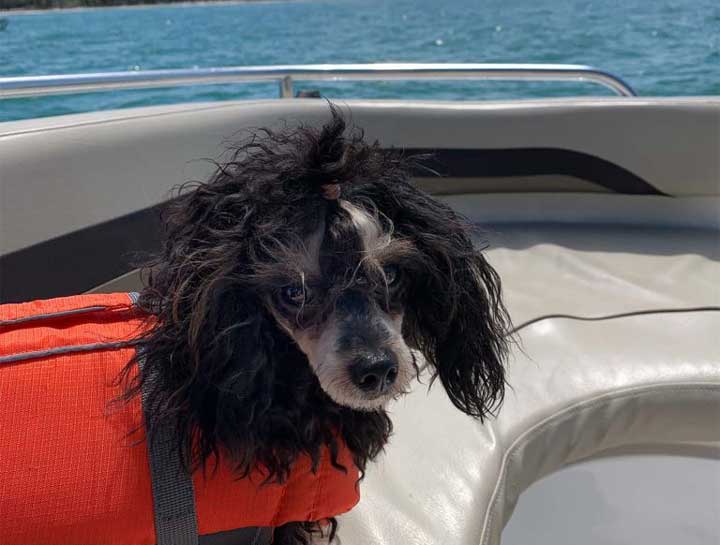Traveling With Your Dog: Boating

In our continuing “Traveling With Your Dog…” series, we want to share some tips on boating safety. Temperatures are rising and ‘tis the season to be out on the water, whether that be on a kayak, canoe, or larger vessel. It can be a lot of fun to bring your dog along for the adventure, but caution is key to a successful day of boating safely with your dog.
So before you head out to enjoy the sun and waves, take a moment to ensure you have everything you need to keep your dog 1 comfortable and safe.
Life Jacket
To many, a life jacket may seem unnecessary–after all, dogs are natural swimmers, right? Not all dogs know what to do when plunged into the water. Brachycephalics, or flat-faced dogs, and dogs with broad chests often have difficulty swimming.
We witnessed someone carrying their English bulldog off a boat and wading through a small stretch of water to get to an island. At some point, the dog was dropped face-first into the water and had a difficult time righting itself—it was scary, to say the least!
Even a dog that can swim well horizontally may go under vertically when they reach a boat and attempt to get back in. Also, in case of an emergency, a dog may have to swim for a long period, or may be injured when going into the water.

A life jacket will help dogs float in the event they tire out, get injured, or lose consciousness. A brightly colored vest and a handle on the back are important features when vest shopping, as is a good fit. If you have a puppy, do not buy a larger size with the thought that they have room to grow into it.
Going Overboard
Be aware that some dogs may try to jump off the boat if they see something interesting, like a bird or fish. So it may be a good idea to keep them leashed. We don’t recommend tethering the leash to the boat, however, in case there is an emergency and everyone needs to disembark.
It’s important to have an emergency plan in place if your dog does go overboard. If the boat is in motion, cut the engine until you can ensure your dog is out of danger of hitting the prop. If your boat doesn’t have a motor, or you’ve made sure your pet isn’t going to be injured by the prop, circle back to your dog. Cut the motor when you get close enough.
It may be tempting to jump in to save your dog, but this can be very dangerous. Just like humans, dogs can panic and drag you under as they struggle to keep their heads above the water. Instead, get close enough that you can reach them, calling them over to the boat. Use the life vest handle to pull the dog up.
First Aid Kit
It’s a good idea to consult your vet regarding items to include in a first aid kit for your specific dog. If your dog is prone to motion sickness, the doctor may be able to prescribe medication to help. Also, while it can be good to include hydrogen peroxide to induce vomiting if your dog ingests something it shouldn’t, there is a danger. Some things your dog can ingest can cause more harm than good if they are vomited back up. So include your vet’s phone number in the first aid kit so that you can consult them in a situation like this.
Basic items to include are:
- Vet Wrap (this sticks to itself and not your dog’s fur.
- Non-Stick Bandages to place over the wound before applying vet wrap.
- Scissors
- Tweezers
- Saline solution to flush wounds or eyes
- Muzzle (some dogs try to bite when they’re hurt and in pain)
- Pliers (for removing fish hooks)
A towel is also a great help to bring along. Also, it would be a good idea to learn how to perform CPR on a dog that has suffered from near-drowning. Please read our blog post about resuscitating your pet.
Sunscreen
Dogs can get sunburned too! Light-colored dogs with pink skin are especially susceptible to burns, particularly when they have thin fur. Dogs can also burn where the fur parts are, on the top of their nose, and their ears.

A hot dog may lay on their side to help cool off, exposing its belly to the sun in the process. Provide shade to help prevent sunburn, and use a pet-friendly sunscreen. It’s important to only use sunscreen made especially for pets, as dogs will often lick their fur.
Fresh Water
It’s important to not only provide fresh water but also prevent your dog from drinking salt water. Saltwater consumption can lead to diarrhea and vomiting. Ingesting large amounts of salt water can lead to dehydration and can even be fatal. Be sure to bring along a water bowl as well.
Poop Bags
Just like any outing with your dog, be sure to bring poop bags and a large bag to throw the trash into. Believe us, it’s no fun to stop at an island and have no place to throw away a poop bag! Speaking of islands, be sure to acquaint yourself with which areas allow your dog to explore. Certain locations have a “no pet policy” to protect wildlife.
Once you and your dog begin to explore a beach, there are several things to keep in mind to keep safe. So be sure to check out our beach safety article.
With these safety tips, we hope you have a fun–and safe–boating day with your dog!
